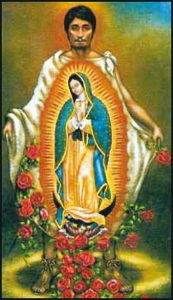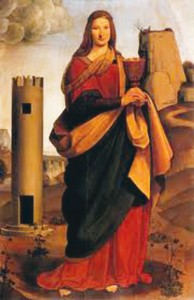December Saints
Saint Barbara was brought up by a pagan father, Dioscorus, who kept her secluded in a lonely tower where this very gifted woman undertook to study religion and became a Christian.
When she was of an age to marry, she refused every suitor’s demands. On finding all the pagan idols he had placed in her tower destroyed, and discovering his daughter’s conversion, Dioscorus was furious. She escaped and dwelt for a time in a cavern, hidden by vegetation at the entrance. But finally her father’s threats of chastisement for anyone who might be concealing her caused some local shepherds to reveal her retreat.
Her father denounced her to the civil tribunal, and Barbara was horribly tortured twice, and finally beheaded.
Saint Barbara, preserve us from a sudden and unprovided death.
(Source: www.magnificat.ca/cal/engl/12-04.htm)
 Saint Juan Diego (16th century)
Saint Juan Diego (16th century)
Details of Saint Juan Diego’s life are sketchy. What we do know is that on 9 December 1531, Juan Diego was walking the fifteen miles to daily Mass. As he crossed the Hill of Tepevac, he was struck by an unusual fragrance. He heard beautiful music and saw the sky change into gorgeous colours. From bright light emerged a beautiful dark-skinned lady who spoke to the frightened Indian. “I desire a church in this place where your people may experience my compassion… Here I will see their tears; I will console them and they will be at peace.”
Juan went to the Bishop, who was at first sceptical and demanded a sign, to which Juan agreed. Juan’s uncle was ill with a fever, and he took care of the elderly man before seeking the lady again. Sensing that his uncle was about to die, Juan ran for a priest. He was met by the lady and told that his uncle was cured.
The lady then identified herself as Our Lady of Guadalupe. When Juan asked for a sign, he was told to go to the nearby rocks and gather the roses. Despite the freezing temperatures, he found a full bloom of Castilian roses which he gathered into his tilma (cape). The lady told him, “This is the sign I am sending to the Bishop… This time the Bishop will believe you.”
Juan obeyed the lady and again approached the Bishop, opening his tilma and letting the flowers spill out. But it wasn’t the roses that caused the Bishop and his advisors to fall to their knees – it was the image of the Blessed Virgin, exactly as she had appeared to Juan, imprinted on the tilma.
Juan Diego was very ordinary and natural, and he felt at home with Our Lady. He remained faithful until death and is considered a model of the lay apostle. He was the only person on earth to whom Mary gave her own picture. The importance of this humble man’s carrying out the divine plan can hardly be more clearly exemplified.
At his beatification, Pope John Paul II said: “At the dawn of Mexican evangelisation, Blessed Juan Diego holds a place all by himself; according to tradition, his indigenous name was Cuauhtlatohuac, ‘The Eagle Who Speaks’… His lovable figure is inseparable from the Guadalupe event, the miraculous maternal manifestation of the Mother of God.”
Saint Juan, give us a true devotion to Our Lady.
(Sources: Internet: various. John Paul II’s book of saints. Matthew, Margaret & Stephen Bunson. Our Sunday Visitor, Huntington, Indiana. 1999)
Saints Tharsilla and Emiliana of Rome (6th century)
Tharsilla was an aunt of Pope St Gregory the Great, and what is known about her comes largely from his writings.
Gregory’s father, Gordian, had three sisters who, when they were young, lived under strict discipline as nuns in their father’s house. One of them eventually left to marry but Tharsilla and her sister, Emiliana, continued to maintain their way of life. Encouraging one another to virtue by discourse and example, the two sisters soon progressed rapidly in the spiritual life.
One day Tarsilla had a vision, in which Pope Saint Felix, her uncle, appeared to her and showed her a palace of marvellous beauty. The next day she fell ill with a fever, which rapidly grew worse and she died on December 24th.
A few days afterwards she appeared to her sister Emiliana, saying: “My sister, come! I did not celebrate with you the birth of the Lord, but together we will celebrate the feast of the Epiphany.” Emiliana fell ill and joined her sister on 5th January.
Saints Tharsilla and Emiliana, obtain for us the grace to see the emptiness of this world...
(Source: www.magnificat.ca/cal/engl/12-24.htm#tarsille)
Tagged as: December Saints, Our Lady, Saint Barbara, Saint Juan Diego
Comments are closed.

 Entries(RSS)
Entries(RSS)